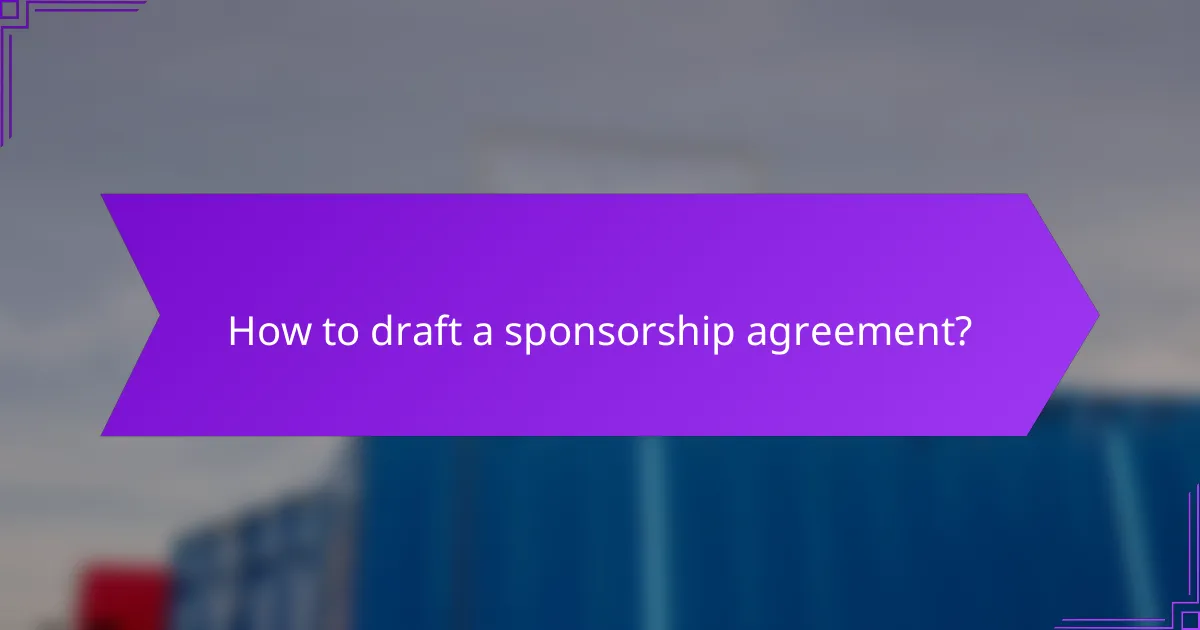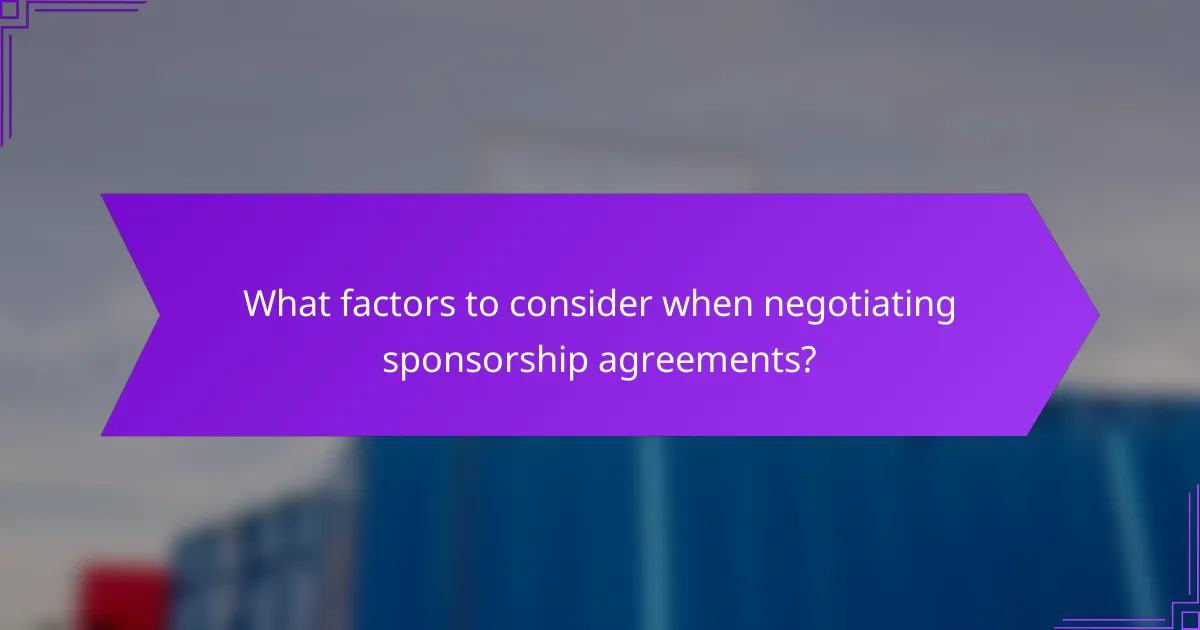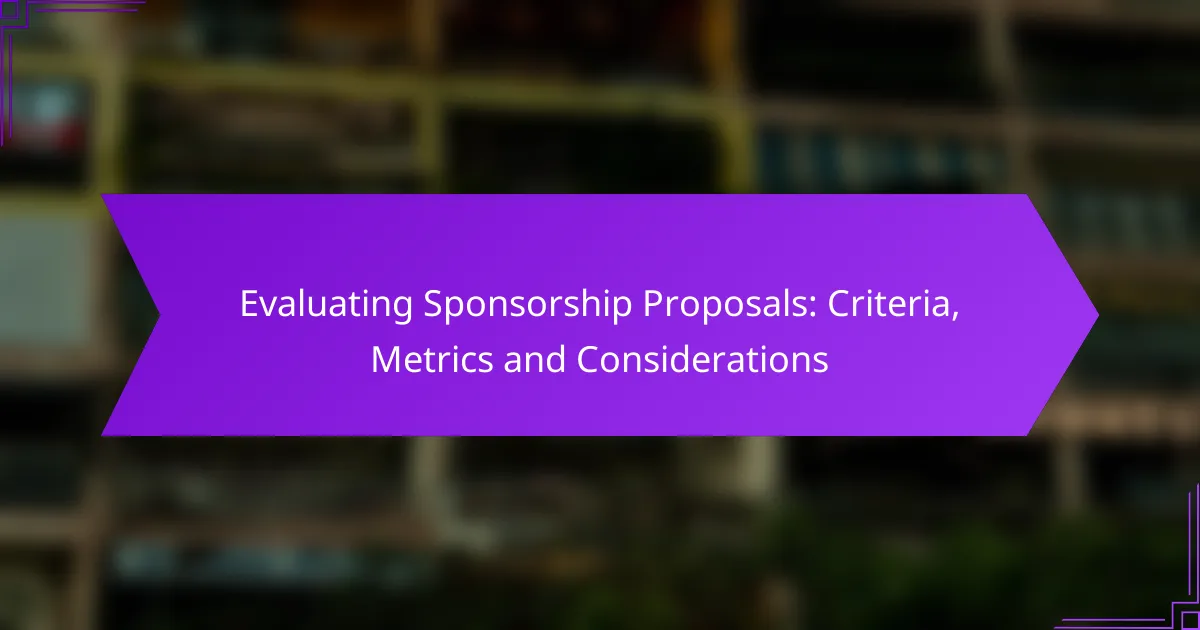A sponsorship agreement is a crucial document that outlines the relationship between a sponsor and the sponsored party, detailing essential elements such as the parties involved, the scope and duration of the sponsorship, and financial terms. It is important to clearly define the terms and conditions to ensure mutual understanding, including objectives, responsibilities, and legal obligations. Additionally, key terms like exclusivity clauses and liability limitations help establish the legal framework of the partnership.

What are the key elements of a sponsorship agreement?
A sponsorship agreement typically includes essential elements that define the relationship between the sponsor and the sponsored party. Key components include the parties involved, the scope of sponsorship, the duration of the agreement, financial terms, and termination clauses.
Parties involved
The parties involved in a sponsorship agreement are usually the sponsor, who provides financial or in-kind support, and the sponsored entity, which could be an individual, organization, or event. Clearly identifying both parties is crucial for establishing responsibilities and expectations.
Each party should be defined with their legal names and roles in the agreement. This clarity helps prevent disputes and ensures that both sides understand their commitments.
Scope of sponsorship
The scope of sponsorship outlines what the sponsor will receive in return for their support. This can include brand visibility, promotional opportunities, and specific rights to use the sponsored entity’s name or logo.
It is important to detail the specific benefits, such as event signage, social media mentions, or exclusive access to certain events. This ensures that both parties have aligned expectations regarding the sponsorship’s impact.
Duration of agreement
The duration of the agreement specifies how long the sponsorship will last. This can range from a single event to multiple years, depending on the nature of the sponsorship and the goals of both parties.
Including start and end dates, as well as any renewal options, can help manage expectations and provide a clear timeline for both parties. This clarity can also facilitate future negotiations.
Financial terms
Financial terms detail the monetary aspects of the sponsorship, including the total amount of funding or value of in-kind contributions. It should specify payment schedules, methods, and any conditions tied to the funding.
Understanding the financial obligations is crucial for both parties. For example, sponsors may want to know if payments are due upfront or in installments, while the sponsored party should be clear about how funds will be used.
Termination clauses
Termination clauses outline the conditions under which either party can end the agreement prematurely. Common reasons for termination include breach of contract, failure to meet obligations, or changes in circumstances.
Clearly defined termination terms help protect both parties and provide a clear exit strategy. It is advisable to include notice periods and any penalties for early termination to avoid misunderstandings.

How to draft a sponsorship agreement?
To draft a sponsorship agreement, clearly define the terms and conditions that govern the relationship between the sponsor and the sponsored party. This includes outlining objectives, responsibilities, and legal terms to ensure mutual understanding and compliance.
Identify objectives
Identifying objectives is crucial for a successful sponsorship agreement. Both parties should articulate what they hope to achieve, whether it’s brand exposure, sales growth, or community engagement. Setting clear goals helps in measuring the success of the partnership.
For example, a sponsor may aim to increase brand awareness by a certain percentage, while the sponsored entity might seek to enhance event attendance. These objectives should be specific, measurable, and aligned with both parties’ interests.
Outline responsibilities
Outlining responsibilities ensures that both parties understand their roles and contributions. The agreement should detail what each party is expected to deliver, such as promotional activities, event participation, or financial commitments.
For instance, the sponsor might be responsible for providing funds or products, while the sponsored party may need to display the sponsor’s logo prominently or mention the sponsor in communications. Clearly defined responsibilities prevent misunderstandings and foster accountability.
Include legal terms
Including legal terms is essential to protect both parties in a sponsorship agreement. This section should cover aspects such as liability, confidentiality, dispute resolution, and termination conditions. Legal clarity helps mitigate risks and ensures compliance with relevant regulations.
For example, specifying how disputes will be resolved—through mediation or arbitration—can save time and resources. Additionally, including clauses about intellectual property rights can protect branding elements used during the sponsorship.

What are common terms and conditions in sponsorship agreements?
Sponsorship agreements typically include essential terms and conditions that outline the responsibilities and expectations of both parties. Key elements often cover exclusivity clauses, liability limitations, and intellectual property rights, which help define the scope and legal framework of the partnership.
Exclusivity clauses
Exclusivity clauses prevent sponsors from partnering with competing brands during the agreement’s term. This ensures that the sponsor’s brand receives undivided attention and visibility, which can enhance marketing effectiveness.
When negotiating exclusivity, consider the duration and scope. For example, a sponsor may request exclusivity in a specific market segment, like sports apparel, for the entire duration of the sponsorship. Be cautious of overly broad clauses that could limit future opportunities.
Liability limitations
Liability limitations define the extent to which each party is responsible for damages or losses arising from the sponsorship. These clauses are crucial for protecting both sponsors and sponsored entities from unforeseen circumstances.
Typically, liability is limited to direct damages and excludes indirect or consequential losses. For instance, if a sponsored event is canceled, the sponsor may only be liable for costs directly associated with the event, not for lost profits. Always ensure that these limitations are clearly stated to avoid disputes.
Intellectual property rights
Intellectual property rights in sponsorship agreements dictate how logos, trademarks, and other brand elements can be used. These rights are vital for protecting brand identity and ensuring proper representation in marketing materials.
Both parties should clearly outline the permissions granted for using each other’s intellectual property. For example, a sponsor may allow the use of its logo on promotional materials, while the sponsored entity must ensure that the logo is displayed correctly and in accordance with brand guidelines. Always seek legal advice to navigate these rights effectively.

What are the benefits of a sponsorship agreement?
A sponsorship agreement provides numerous advantages for both sponsors and the entities they support. These benefits include enhanced brand visibility, improved engagement with target audiences, and valuable networking opportunities that can lead to future collaborations.
Brand visibility
One of the primary benefits of a sponsorship agreement is increased brand visibility. By associating with events, organizations, or individuals, sponsors can reach a wider audience and enhance their brand recognition. For example, sponsoring a local sports team can place a company’s logo on uniforms and promotional materials, making it visible to fans and participants.
To maximize brand visibility, sponsors should consider the alignment of their brand with the sponsored entity. A well-matched partnership can amplify exposure and reinforce brand values, making the sponsorship more effective.
Target audience engagement
Sponsorship agreements facilitate direct engagement with a target audience. By sponsoring events or initiatives that attract specific demographics, sponsors can connect with potential customers in a meaningful way. For instance, a tech company sponsoring a coding bootcamp can engage with aspiring developers who are likely to be interested in their products.
To enhance audience engagement, sponsors should actively participate in the sponsored events. This could involve setting up booths, offering interactive experiences, or providing exclusive promotions, which can create a memorable connection with attendees.
Networking opportunities
Sponsorship agreements often open doors to valuable networking opportunities. By participating in sponsored events, sponsors can meet industry leaders, potential clients, and other stakeholders. This can lead to collaborations, partnerships, and new business opportunities that might not have been available otherwise.
To maximize networking benefits, sponsors should approach events with clear objectives. Identifying key individuals to connect with and preparing to engage in meaningful conversations can significantly enhance the value gained from these networking opportunities.

What factors to consider when negotiating sponsorship agreements?
When negotiating sponsorship agreements, it is crucial to consider the objectives of both parties, the value being offered, and the terms of engagement. Understanding these factors can lead to a mutually beneficial partnership that aligns with marketing goals and brand values.
Market trends
Market trends play a significant role in shaping sponsorship agreements. Staying informed about industry shifts, consumer behavior, and emerging platforms can help both sponsors and properties identify opportunities for collaboration. For instance, the rise of digital media has shifted many sponsorships towards online platforms, making it essential to adapt strategies accordingly.
Additionally, analyzing competitor sponsorships can provide insights into what works well in your specific market. This can include examining the types of sponsorships that are gaining traction, such as influencer partnerships or event sponsorships, and understanding how they resonate with target audiences.
To effectively leverage market trends, consider conducting regular market research and engaging with industry reports. This proactive approach can help in negotiating terms that reflect current market dynamics and maximize the value of the sponsorship agreement.



